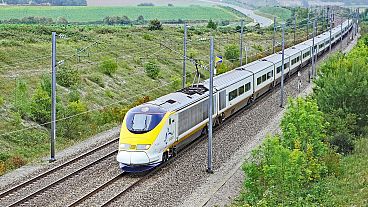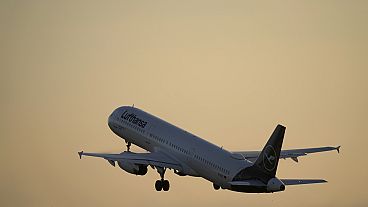Travel
From France to the moon: rocket simulator opens in Toulouse

The Cité de l’Espace centre is offering visitors the experience of space travel in a rocket and moon lander simulator.
In Toulouse, France, the Cité de l’Espace is launching a new immersive experience: Lune Xplorer, where you can take a seat in a rocket simulator.
You can climb aboard a spaceship similar to the one that will soon take man back to the Moon.
Every detail is realistic, including the number of passengers: four per capsule. The simulator is in fact a centrifuge that reproduces all the effects of acceleration.
“We were really caught up, glued to the seat… As soon as we moved our heads we really lost north and south, but it was really cool,” said one visitor.
Veteran astronauts and NASA staff are on hand to brief the tourist space crews. They say it’s a true-to-life experience.
“What’s amazing is that the accelerations and decelerations we put you through are real. It’s like being in a real rocket,” explained NASA veteran Jean-François Clervo.
The attraction has opened amid a flurry of new unmanned space missions to the moon. NASA aims to return people to the lunar surface in 2026.
You might also like

Now playing

Now playing

Now playing
Travel
Intercités, Ouigo, TER: France announces discounted train fares throughout September
Want to explore France by train this September? Look out for these cheap ticket sales.
Sad to see the end of summer? September is still a great time for a train adventure thanks to extended deals from French national rail operator SNCF.
Throughout the month, its ‘Les Jours Traincroyables’ campaign promises to “extend the summer” with a series of ticket offers on Intercités, Ouigo, TER and TGV INOUI trains.
Various flash sales are planned until 30 September offering discounted journeys on regional and longer distance high-speed services.
To secure cheap train travel in France and beyond, here are the dates to put in your calendar.
Flash sales on French trains this September
SNCF Voyageurs’ month of discounts kicks off with a Ouigo flash sale on 4-5 September. It will see 200,000 tickets on the operator’s classic and high-speed trains sold for a maximum of €19 each.
The high-speed train service offers low-cost travel throughout France and onward to destinations in Spain.
Stay on alert from 10-13 September, when 30,000 tickets between Normandy and Paris costing no more than €12 will be released in the Nomad Train Flash Sale.
Cheap tickets (between €3 and €13) will also be available in the eastern region of Bourgogne-Franche-Comté, and to or from Paris, all month long.
Further west, under-26-year-olds can take advantage of €4 to €15 tickets for travel in Brittany, while down south in Nouvelle-Aquitaine under-28s can travel for just €2.
Heading to the northern Hauts-de-France region? Here, bargain €2 train tickets have no age limit – and 5,000 of them will be released each day throughout September.
To catch the end of the green season in the mountains, travel on Saturdays for a 40 per cent group discount on TER Auvergne-Rhône-Alpes trains.
Cheap train travel in Europe this September
The train ticket deals aren’t limited to French destinations. Between 18-29 September, you can discover Europe thanks to €39 tickets with TGV INOUI and TGV Lyria.
TGV INOUI operates high-speed trains to over 200 destinations in France and Europe, including in Germany, Italy and Spain, while TGV Lyria operates between France and Switzerland.
A further sale on TGV INOUI and Intercités trains from 23-27 September will offer tickets from €19 to €29, with an upgrade to first-class costing just €1 extra.
For cheaper train travel in Europe all year round, take advantage of the Carte Liberté, which offers fixed rate discounts to frequent travellers and is currently available at up to €80 off.
Travel
Flying on a plane is safer now than ever before, study finds
A recent study has found that flights are safer than they’ve ever been.
There’s a one in 13.7 million chance that a passenger anywhere in the world will die onboard an aircraft, according to a new study.
Researchers from the Massachusetts Institute of Technology (MIT) in the US analysed global passenger and fatality data between 2018 and 2022 and found deaths on planes dropped by an average of 7 per cent year over year.
Those results follow a pattern of “continuous improvement” that started in 1968 when the death rate fell an average of 7.5 per cent per year even as more flights took off and landed.
It comes as US aircraft manufacturer Boeing faces a series of technical issues that forced the company to ground the test flights of their 777-9 model. The Federal Aviation Authority (FAA) also reportedly has launched inspections into the 787 Dreamliner due to faulty pilot seat movements.
Death rate 36 per cent higher in some countries
The incident rate depends on what countries people are flying to and from, with researchers dividing countries into three tiers for low, medium and high risk based on air safety record.
The lowest risk is the Tier 1 group which includes the European Union, Australia, Canada, China, Israel, Japan, Montenegro, New Zealand, Norway, Switzerland, the United Kingdom, and the United States.
Some examples of countries in the Tier 2 group include Bahrain, Bosnia, Brazil, Brunei, Chile, Hong Kong, India, Jordan, Kuwait, Malaysia, Mexico, Philippines, Qatar, Singapore, South Africa, South Korea, Taiwan, Thailand, Turkey, and the United Arab Emirates.
The rest of the world’s countries are in Tier 3 or the high-risk group.
For the first two tiers, the death risk falls to one per 80 million passenger boardings, the study found. These countries account for more than half of the world’s 8 billion people.
“At that rate, a passenger could on average choose one flight at random every day for 220,000 years before succumbing to a fatal accident,” the report continued.
The fatality risk is around 36 per cent higher for tier 3 countries, the study found, but fatalities are still falling.
“While [these nations] continue to get better over time, their passenger death risk remains many times as high as the risk elsewhere,” the study says.
The study also didn’t include any accidents that were direct attacks on passengers, like a suicide bombing at Kabul airport in 2021 that killed 170 Afghans and 13 US military troops.
Over 4,000 deaths from catching COVID on a plane
The study accounts for the COVID-19 pandemic which they defined as the period from March 2020 to December 2022. While there were fewer airline passengers during the pandemic, those who travelled faced a “new source of danger” if exposed to the virus on a flight.
Airlines at the time told passengers that COVID-19 transmission was “all but impossible,” the researchers say in their study, even though the US surgeon general estimated that 96 per cent of flights during that time had at least one positive passenger.
Despite that new risk, researchers say that there “is no evidence that those who did fly suffered a greater risk of death from plane crashes or attacks than would have been expected had the pandemic never occurred”.
“Outside of on-board transmission of COVID-19, passenger safety did improve sharply,” the study said.
In total, the paper estimates that roughly 4,760 people died from contracting a COVID-19 infection on a flight from March 2020 to December 2022.
The MIT researchers do admit that it’s hard to know the exact number of deaths since passengers who got an infection after a flight could’ve passed it on to others who might have passed away.
“These estimates about COVID-19 deaths are necessarily imprecise,” the study says. “And while they use lower-end parameter estimates, they could well be too high”.
Their data also doesn’t count any passengers under 18 and doesn’t differentiate the age of any passengers over 65, which the researchers say is important because mortality goes sharply up for the elderly.
Travel
‘Paradise ruined’: Why Spanish locals fed up with overtourism are blocking zebra crossings
In northwestern Spain, villagers blocked zebra crossings to protest too many tourists – but ended up causing a huge traffic jam.
Spain has seen many overtourism protests this year, but one small village has been making its grievances known in a very unusual way.
In the Galician village of O Hío in northwest Spain, locals took it upon themselves to protest against the volume of tourists by blocking zebra crossings.
Walking up and down them for a total of 37 minutes, they caused total traffic gridlock – worsening the exact problem they hoped to highlight.
Nevertheless, residents stand by their decision.
Why are Spanish locals blocking zebra crossings?
“Traffic problems are already common, but this year they have tripled at least,” resident Mercedes Villar told local newspaper La Voz de Galicia. “It’s an avalanche of cars that not only pollutes but also affects everyone’s lives because they park wherever they want. We have the right to live too.”
Locals from the small coastal village say, while they’re not against tourism per se, they want authorities to find a mutually beneficial solution so that residents and visitors can co-exist happily.
They say their driveways are being blocked, traffic accidents are increasingly common and that parking-controlling yellow lines are being ignored.
“The protest was meant to raise awareness and sound the alarm,” another villager told La Voz. “We want people to be civil and understanding and, if they see that there is no parking space, to leave, as we all have to do in any city.”
Rogue parking by tourists creates ‘danger’ for locals
Villar, who is the spokesperson for the residents’ association, added that while locals tend to park their cars properly, visitors who don’t are creating “a situation of insecurity and danger”.
Villagers raised concerns that the situation causes access problems for emergency vehicles, citing residents who needed to be collected by ambulance, but found the exits from their houses blocked or their transport delayed due to the sheer number of vehicles on the streets.
Speaking to La Voz, Villar added that the significant amount of traffic had led to “uncivil” behaviour, including visitors littering the roads and parking areas.
She also says that too much traffic has led to the deterioration of some roads. “We want orderly and polite tourism that respects the environment. This is a paradise, but paradises also get ruined,” she said.
Locals have been invited to discuss their complaints
Like many Spanish people protesting against overtourism, Villar believes that the growing popularity of her local area has a lot to do with social media’s impact.
“This is sold as a beautiful place with no people, but now that is not true,” she explained, adding that residents tend to avoid beaches during tourist season as they are simply too busy.
She hopes that the zebra crossing protests will have laid bare how “annoyed” locals are with the situation.
It seems to have worked – in response, the local council has invited disgruntled locals to a meeting to discuss their complaints later in September.
From Cantabria in the north to Málaga in the south, growing numbers of Spanish people are calling for the government to change the face of mass tourism, which they believe is getting out of hand.
They say its impact is having a negative effect on property prices and rents as well as standard of living for residents.
-

 EU & the World5 days ago
EU & the World5 days ago‘HSM’ Alum Bart Johnson Defends Sister-In-Law Blake Lively Amid Online Backlash
-

 Sports2 days ago
Sports2 days agoMercedes celebrates Monza: “Goosebumps.”
-

 Politics6 days ago
Politics6 days agoEU Intensifies Pressure: Six-Month Extension of Russia Sanctions
-

 Health & Society5 days ago
Health & Society5 days ago7 Superfoods That Will Boost Your Fitness Results
-

 Sports5 days ago
Sports5 days agoFiorentina miracle: nine qualify for the Conference League rounds
-
Travel4 days ago
Venice 2024 review: ‘Babygirl’ – Nicole Kidman shines in sex-positive BDSM drama
-

 Sports1 day ago
Sports1 day agoCharles Leclerc at Monza outperformed even Michael Schumacher.
-

 Health & Society4 days ago
Health & Society4 days agoMarathon of documentaries on Drug Prevention for International Day Against Drugs









